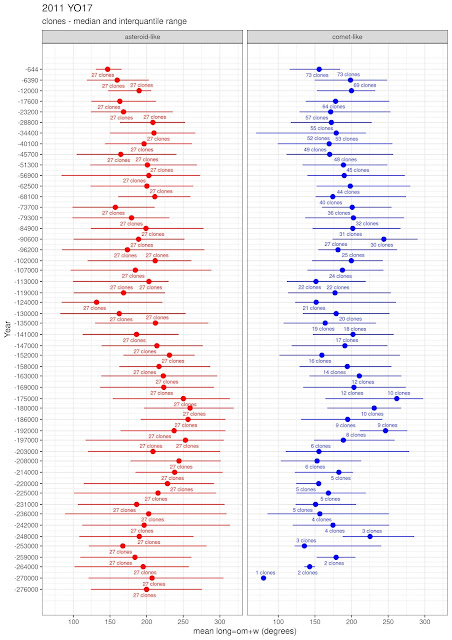2011 YO17 - Backward simulation
Simulation based on 100 clones:
|
Clones | |
Target |
|
mean |
sd |
|
mean |
sd |
|---|
| q |
3.3457192543808 |
2.89972813116376e-07 |
|
3.34571929768682 |
2.8751e-07 |
| e |
0.184121058387053 |
7.17001427077198e-08 |
|
0.184121045157645 |
7.1351e-08 |
| i |
18.249168025204 |
9.19753172889254e-06 |
|
18.2491686171502 |
9.2211e-06 |
| peri |
165.624322571055 |
3.52571408153806e-05 |
|
165.624319088164 |
3.5024e-05 |
| node |
302.902335551023 |
2.30225190945596e-05 |
|
302.902339849507 |
2.2893e-05 |
| tp |
2458883.14050519 |
0.000193613119572893 |
|
2458883.14050091 |
0.00019246 |
the table above shows the orbital parameters distribution of the clones in comparison with the nominal (target) solution.
Simulation method
Mercury Integrator Package Version 6 by J. E. Chambers
)---------------------------------------------------------------------
) Important integration parameters:
)---------------------------------------------------------------------
algorithm (MVS, BS, BS2, RADAU, HYBRID etc) = BS
start time (days)= 2459600.5
) stop time (days) = 102458000.5
stop time (days) = -1d8
output interval (days) = 100
timestep (days) = 0.05
accuracy parameter=1.d-12
...
ejection distance (AU)= 100
If a clone comes into the solar system from a distance greater than 100 AU, it is considered to have a cometary origin.
Simulation Results
73 out of 100 clones have a cometary origin:
In the following plots, the time has been divided into 50 slots and it is shown vertically for graphical reasons.
The 27 clones that did not come from a distance greater than 100 AU are flagged as being on an asteroid-like orbit, while the other are considered to be on a cometary-like orbit (the more you look in the past, the less clones are found because they were "ejected" in the backward simulation).
Perihelium
ApheliumEccentricity
Orbital Period
Orbit specific energy
Inclination
Argument of perihelium
Ascending node
Longitude
Best wishes,
Alessandro Odasso









